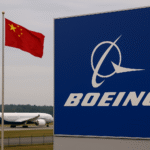Boeing: Turbulence in the Skies Amid Global Trade Disruption
Once a towering symbol of American industrial power and innovation, Boeing now finds itself in a period of extraordinary turbulence. The aerospace giant is navigating through a perfect storm of geopolitical tensions, supply chain disruptions, regulatory hurdles, and market skepticism, particularly regarding its critical relationship with China. These pressures are not just short-term obstacles—they point to a deeper transformation within the global aerospace industry and signal major shifts in how governments, companies, and markets approach economic security.

This article explores Boeing’s mounting challenges, the growing complexities of international trade, and how the company’s current struggles reflect broader global dynamics.
A Decade of Highs and Lows
Boeing’s rise to prominence was built on its pioneering aircraft, strong government ties, and dominance in both the commercial aviation and defense sectors. However, over the last decade, Boeing has been rocked by:
- The 737 MAX crashes and subsequent groundings.
- Delays and quality issues with the 787 Dreamliner.
- A shifting regulatory landscape in global aviation.
- Ongoing labor and supply chain instability post-COVID.
Despite these setbacks, Boeing managed to recover significant ground in the post-pandemic world. But as of early 2025, the company faces a different, potentially more dangerous threat: geopolitical risk.
The China Conundrum
At the heart of Boeing’s current crisis is its complex relationship with China, a market that historically accounted for about 25% of global aircraft demand. Boeing once projected that China would need over 8,000 new aircraft by 2040—a multi-trillion-dollar opportunity.
But here’s the problem:
- U.S.-China trade tensions have escalated sharply.
- China has delayed or canceled aircraft orders from Boeing in recent years.
- Airbus—Boeing’s European rival—has rapidly gained market share in the region.
Following a series of high-level political disputes, including U.S. export controls on semiconductors and Chinese retaliation in various sectors, the aerospace industry has become a new frontline. Beijing is increasingly hesitant to greenlight Boeing deliveries, citing safety and political concerns. Meanwhile, China is actively promoting its domestic aircraft manufacturer COMAC, aiming to reduce reliance on Western aerospace firms altogether.
Grounded Ambitions: The Impact of Trade Tensions
Boeing’s deliveries to China have slowed significantly since 2019, and in 2024, just a fraction of new jets were approved for Chinese carriers. The reasons are both technical and strategic:
- Chinese regulators delayed the return of the 737 MAX until mid-2023.
- National interest in supporting COMAC puts Boeing at a disadvantage.
- Political messaging from Beijing signals preference for non-U.S. suppliers.
This loss is staggering. Each 737 MAX aircraft is worth around $100 million, and China’s rejection of hundreds of orders directly impacts Boeing’s revenue stream and stock valuation.
Boeing’s leadership has lobbied U.S. policymakers to ease tensions, but with tariffs, technology bans, and military rivalries in the mix, business diplomacy alone may not be enough.
Supply Chain and Labor: Additional Headwinds
Boeing’s woes aren’t limited to foreign policy. Domestically, the company is still grappling with:
Supply chain delays for key aircraft components.
A shortage of skilled labor in manufacturing and engineering roles.
Increased regulatory scrutiny from the Federal Aviation Administration (FAA).
Rising production costs due to inflation and new compliance measures.
In an earnings preview, analysts forecast that Boeing’s Q1 2025 performance may fall short of expectations, citing delayed deliveries and weaker-than-expected demand from Asia-Pacific.
Strategic Shifts: Rebuilding Trust and Diversifying Risk
Boeing’s response to these challenges has been multi-pronged:
- Diversifying its customer base
The company is targeting growth in India, the Middle East, and Latin America to offset losses in China. - Expanding defense contracts
As geopolitical instability rises, Boeing is leveraging its defense division to secure contracts from the U.S. government and NATO allies. - Restructuring supply chains
Boeing is increasingly seeking “friendshoring” strategies—moving production and sourcing to allied or neutral countries to reduce exposure to high-risk regions. - Investing in innovation
Despite fiscal constraints, Boeing continues to invest in sustainable aviation technologies, such as hydrogen-powered aircraft and next-gen air traffic systems.
These moves are designed to reduce Boeing’s reliance on politically volatile markets and reestablish its image as a reliable, forward-looking aerospace leader.
What This Means for the Industry
Boeing’s situation is not just a company-specific issue—it’s indicative of a broader shift in global trade and technology. The lines between economic policy, national security, and innovation are increasingly blurred.
Key trends to watch include:
Nationalization of strategic industries: More countries are developing domestic aerospace capabilities.
Increased government intervention: Defense budgets and aviation subsidies are rising.
Techno-economic competition: Aerospace, semiconductors, and AI are the new battlegrounds for superpower rivalry.



